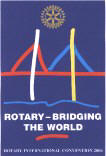BUILDING BRIDGES
By Frank
Deaver
Rotary Club of Tuscaloosa, Alabama USA
Rotarians from around the world, an anticipated 20,000 or more, will
gather in Malmö (Sweden) and Copenhagen (Denmark) next month for the
2006 Rotary
International Convention. The two cities are connected, as of
six years ago, by the Oresund Bridge, the longest bridge-tunnel
road-and-rail bridge in Europe. It’s an impressive span to see, and
testimony to the teamwork of planners and builders.

It is appropriate that the convention theme is “Bridging the
World,” with this engineering spectacular as the logo and as
inspiration for Rotary’s multiple bridging functions.
Indeed, Rotary has been in the bridge-building business for
most of its century of service. Paul Harris, writing in 1944,
challenged Rotarians to be “an integrating force in a world where
disintegrating forces are far more numerous.”
The function of a bridge is far more than to serve as a roadway
for feet, vehicles, and trains. Rotary has for decades been
building bridges that span races, cultures, religions, politics, and
languages.
• Bridges connect. The Oresund Bridge connects
two countries in bilateral togetherness, but in 168 countries
Rotarians are connected by bridges of social intercourse,
international understanding, and goodwill, facilitating their
cooperation in humanitarian service.
• Bridges unite. A simple footbridge across a
canyon can unite isolated villages, offering access to schools,
hospitals, and markets. Rotarians build bridges of tolerance and
mutual respect, uniting Rotarians from countries whose governments
may lack similar respect and tolerance.
• Bridges provide. Products are more readily
available and economic opportunities are enhanced because of the
Oresund Bridge, but the Rotary Foundation provides travel and
educational opportunities for scholars, Group Study Exchange teams,
and others.
• Bridges project. Concrete and steel span only
a measurable distance, but Rotary functions project unlimited
friendship of peoples from around the world. Barriers are overcome
through the bridge of communication, enhanced in recent decades by
the technology of the internet.
• Bridges perpetuate. While the Oresund Bridge can be
expected to facilitate travel for many years, Rotary, now in its
second century, bridges generations with an ongoing vision for
international understanding and peace.
Perhaps Will Allen Dromgool said it best in his poem “The
Bridge Builder.” He told of an old man who, with little effort,
crossed a treacherous chasm, then turned and built a bridge. When
asked why he did that, after his own safe crossing, the old man
said,
“There follows after me today
A youth whose steps must pass this way.
This chasm that meant naught to me,
To the fair-haired youth might a pitfall be.
He too must pass in the twilight dim;
Good friend, I'm building this bridge for him.”
As Rotarians gather beneath the banner of “Bridging the
World,” we must think beyond the Malmö-to-Copenhagen span that will
be our symbolic logo. There are far more bridges to be crossed.

